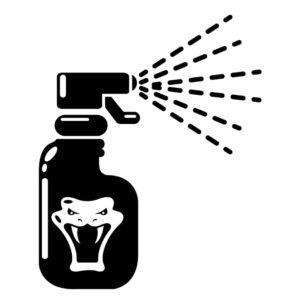
I spent a few hours finding out what ingredients are commonly used in snake repellents. Some commercial repellents use natural elements while others use chemical substances. Read to the very bottom of this article to see what ingredients you might find in snake repellents. The article below will answer all your queries regarding widely used ingredients in snake deterrents along with their consequences.
Ingredients in Snake Repellents
Snake repellent products are either composed of non-natural substances or natural/organic substances. Let’s categorise them to make it easy for us to remember which ones are more effective and environment-friendly.
Non-Natural Ingredients
Many commercial snake repellents use a blend of non-natural substances as active ingredients to do the shooing away job. Some of the most common non-natural constituents are:
-
Naphthalene
Naphthalene is one of the most common active components of many commercial repellents like ‘Snake-A-Way. The theory behind its use is that it has a specific kind of smell that bothers serpents. While its effectiveness against snakes is up for discussion, there’s a unanimous agreement on its hazardous effects on humans.
Repeated exposure to this compound can damage your vision (cataract) and cause throat and nose irritation. It might also cause nausea, vomiting or headaches.
-
Mothballs
Mothballs are another common non-natural element. To be more precise, naphthalene is the primary component of mothballs. It is a cheaper alternative of naphthalene. Before you pick a product containing mothballs for deterring the slithering invaders, you should know that it poses a threat to your children and pets. They are toxic and can endanger your kid’s or animal’s health if ingested.
-
Sulfur
Sulfur is also readily used in many factory-made snake-repellent products. Again, Snake-A-Way (Victor VP364B) is an example of that. The manufacturers claim that powdered sulfur irritates the scaly skin of snakes when comes in contact with the substance. The substance emits a strong and unpleasant scent. So, put on a mask during application to avoid putting your nose and mouth through hell.
-
Ammonia
You will find ammonia as one of the main components in several repellents. The stinging odour of ammonia spray targets the serpent’s sense of smell, forcing it to flee the treated territory. People also make a solution of ammonia and dip rugs in it. These soaked articles are then sealed in a plastic bag and placed near snake-active areas.
The caustic nature of this chemical can cause breathing and skin problems. So, you need to be careful with its use.
Natural Ingredients
Below are some of the most common natural ingredients used for forcing snakes to migrate from an area.
-
Essential Oils
Essential oils are the most common naturally-derived components of many snake deterrents. Extracts of clove, cinnamon, cedarwood, mint, peppermint and rosemary are common essential oils used for driving snakes away. They are environment-friendly and non-toxic. That’s why they are more popular than chemical repellents.
Well-known snake repellent products, such as Ortho Snake B Gon and Pufado Snake Repellent, contain essential oils as active elements.
-
Garlic & Onion Spray
Garlic and Onion are famous natural repellents and home remedies for snake infestation. They contain sulfonic acid—the culprit responsible for making us cry. Yes, that same thing is responsible for scaring snakes away.
-
Vinegar
Vinegar is also a well-known natural snake-repellent idea. I have read many reviews online where people swore that snakes retreated from waterbodies and other such areas where they had splashed vinegar solution.
-
Animal Waste
It sounds ew, but pig dung and fox urine are popular natural remedies for getting rid of these critters. You will find it on many online sources that the snake problem eventually dissipates from areas that smell like pig manure or fox urine. Scientifically, their effectiveness is uncertain.
Other Natural Repellents
Some other popular natural snake repellent ideas are as follows:
- Plants like lemongrass, marigold, wormwood and mother-in-law’s tongue are widely used for repelling snakes.
- Many people claim that spreading rose clippings around places, such as birdhouses, keep snakes at bay. The thorns in this plant damage their skin, forcing them to retreat.
- People keep guinea hens, pigs or turkeys on the premises as watchdogs to keep snakes away. These animals are snake predators and attack the invader. So, their presence scares the serpents away.
- A mixture of lime and peppermint or hot pepper emits a strong aroma that snakes find unpleasant. Besides, the fumes of the solution leave an itchy feeling on their skin. Therefore, they opt to move out of that area.
Note: The effectiveness of both natural and chemical repellents is doubtful. However, the techniques that undoubtedly help you get rid of serpents are:
a). Professional wildlife expert or a pest control service
b). Snake traps
c). Modifications and repair touches to your property to erase favourite elements of snakes.
d). Snake-proof fencing.
Conclusion
Snake repellents use a variety of ingredients, both natural and non-natural, to control snake invasion on your land. Some of these are lethal while others are completely environment-friendly. Now, that you have read about the common components of snake repellent products, you will know which one to choose and which one to steer clear of in future. Instead of diverting toward harsh methods, it is advisable to choose humane and trusted snake-repelling remedies.
